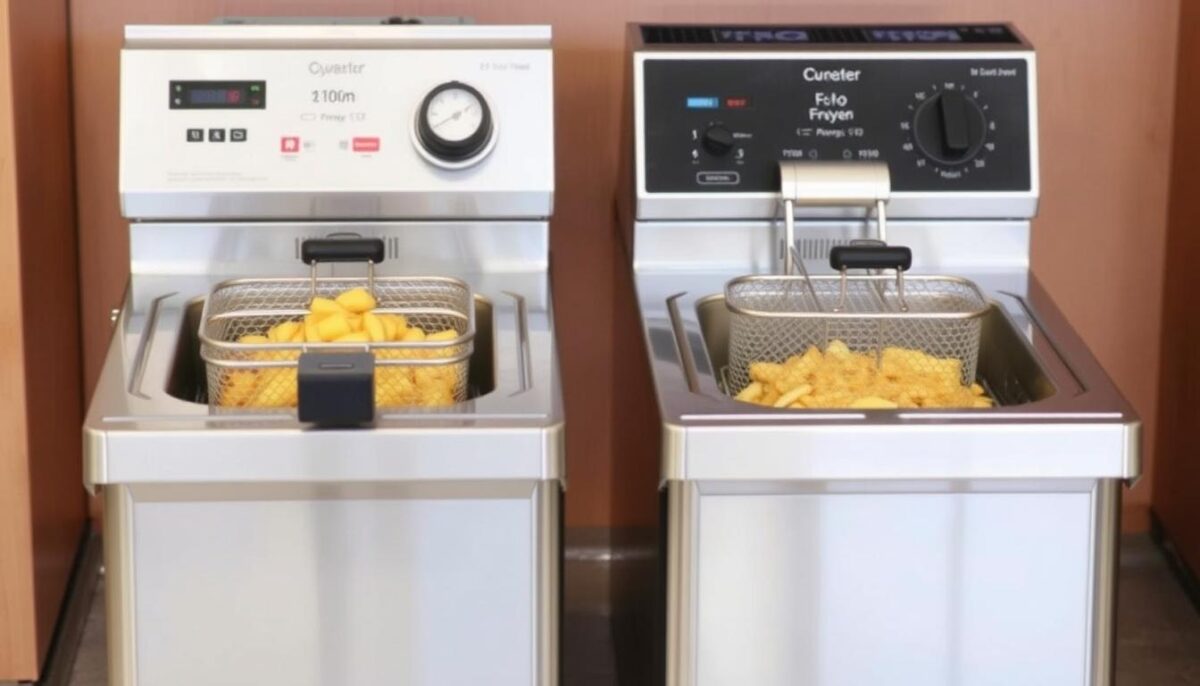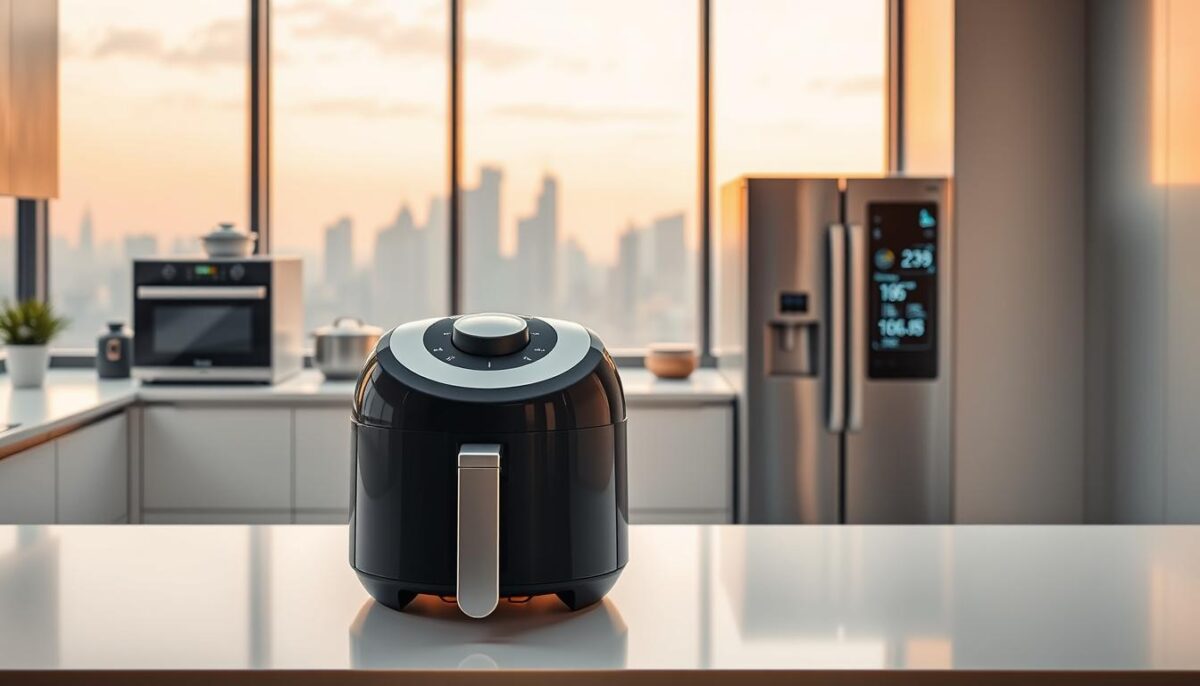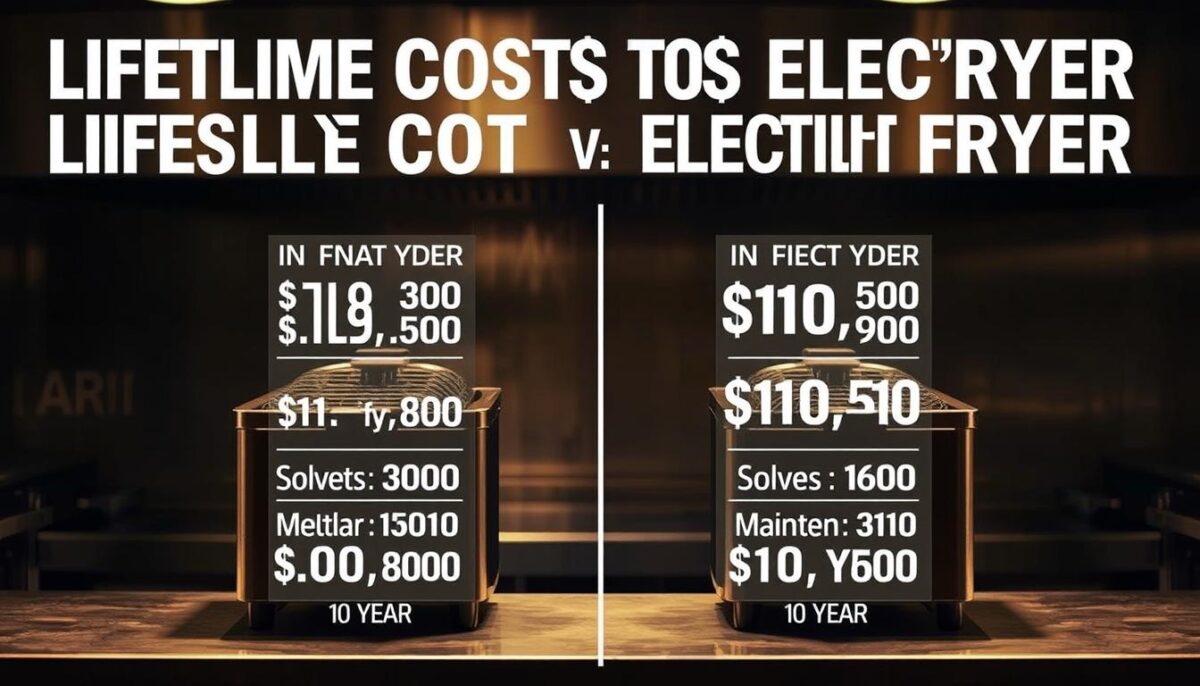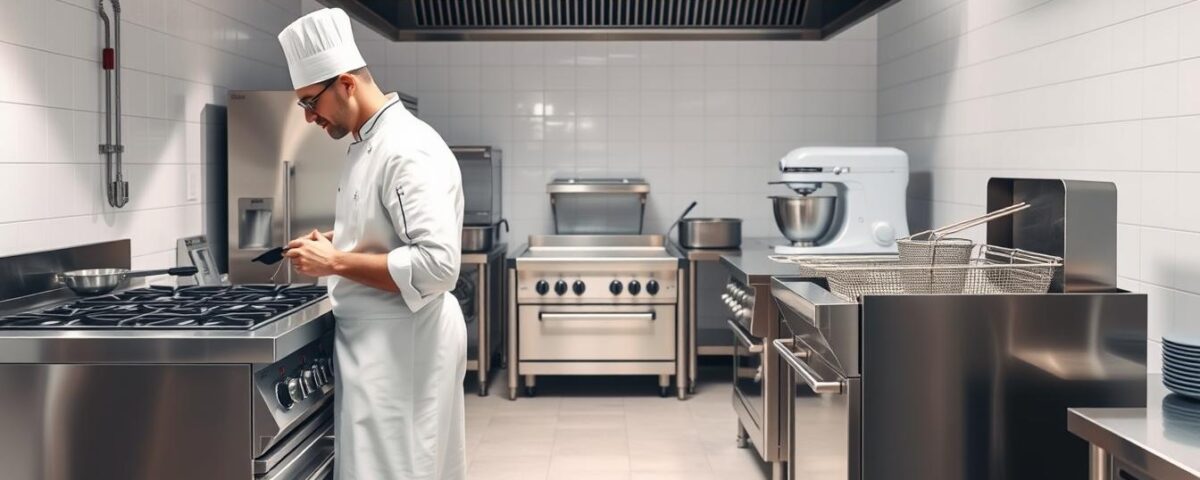
Pitco vs Frymaster: Which Fryer Delivers Crispier Results?
September 13, 2025
6 Key Differences Between Top Commercial Fryer Brands
September 13, 2025As a restaurant owner, I’ve seen firsthand how the right kitchen equipment can make or break your bottom line. When it comes to fryers, the choice between gas and electric models can be daunting. Did you know that the wrong choice can increase your energy bills by up to 30%?
I decided to dive into the numbers to help you make an informed decision. By comparing the operating costs of gas and electric fryers, I’ll reveal the actual expenses behind initial purchase prices, energy consumption rates, and long-term operational expenses. What if switching to the right fryer type could save your restaurant thousands each year?
Let’s explore the real costs and discover which fryer is the most cost-effective for your kitchen.
Key Takeaways
- Comparison of gas and electric fryer operating costs
- Actual numbers behind initial purchase prices and energy consumption rates
- Long-term operational expenses for both fryer types
- Insights on which fryer type is more economical based on business needs
- Tips for making informed kitchen equipment investments
Understanding Commercial Fryer Basics
The versatility of commercial fryers makes them an essential piece of equipment in many food service establishments. Commercial fryers are specifically designed for smaller kitchens, allowing businesses to expand their menu offerings without the need for a full-size fryer. Their compact size makes them ideal for concession stands, cafes, food trucks, and restaurants with limited space.
How Commercial Fryers Work
Commercial fryers operate by heating oil to precise temperatures, typically between 325-375°F, and maintaining that heat throughout the cooking process. This precise temperature control is crucial for producing high-quality fried foods. The heating elements, whether gas or electric, are designed to quickly recover the oil temperature after food is submerged, ensuring consistent cooking results.
Key Components of Commercial Fryers
The key components of commercial fryers include heating elements, thermostats, oil tanks, and filtration systems. Understanding these components is essential for maintaining the fryer’s performance and longevity. The design of these components can vary between gas and electric models, impacting their operational characteristics and maintenance needs.
| Component | Function | Importance |
|---|---|---|
| Heating Elements | Heat oil to desired temperature | High |
| Thermostats | Regulate oil temperature | High |
| Oil Tanks | Hold cooking oil | Medium |
| Filtration Systems | Clean cooking oil | Medium |
By understanding how commercial fryers work and their key components, businesses can better maintain their equipment, ensuring optimal performance and longevity.
Gas Fryers: Technology and Operation
When it comes to commercial frying, gas fryers stand out for their rapid heating capabilities. Gas fryers use natural gas lines from a building or propane tanks to operate, offering a powerful alternative to electric fryers.
How Gas Fryers Heat Oil
Gas fryers utilize combustion technology to generate intense heat for commercial frying operations. They typically feature burner tubes that transfer heat to the oil through either direct or indirect heating methods. This process allows for efficient heating and precise temperature control.
Types of Gas Fryers
There are three main types of gas fryers: tube-type fryers, flat bottom fryers, and open pot fryers. Tube-type fryers are ideal for breaded foods, while flat bottom fryers are perfect for floating items like donuts. Open pot fryers offer easy cleaning and maintenance, making them a practical choice for many kitchens.
Gas Fryer Performance Characteristics
Gas fryers are known for their rapid heating capabilities and ability to recover temperature quickly between batches. Key performance metrics include BTU ratings and thermal efficiency percentages. These factors directly impact the fryer’s real-world cooking performance and efficiency.
| Fryer Type | BTU Rating | Thermal Efficiency |
|---|---|---|
| Tube-Type | 40,000 | 80% |
| Flat Bottom | 35,000 | 75% |
| Open Pot | 30,000 | 70% |
Electric Fryers: Technology and Operation
Electric fryers have revolutionized commercial cooking with their ease of use and precise temperature control. They are equipped with heating elements submerged directly in the oil, which allows for efficient heat transfer and faster temperature recovery between batches.
How Electric Fryers Heat Oil
Electric fryers utilize immersion heating elements to directly transfer heat to the surrounding oil. This method ensures that the oil reaches the desired temperature quickly and maintains it consistently, which is crucial for achieving high-quality fried foods.
Types of Electric Fryers
There are various types of electric fryers available, catering to different commercial cooking needs. These include countertop models, floor models, and specialty configurations designed for specific cooking applications. The diversity in models allows businesses to choose the electric fryer that best fits their operational requirements.
Electric Fryer Performance Characteristics
Electric fryers are known for their consistent heating patterns and temperature stability, making them ideal for continuous operation. The performance characteristics of electric fryers, such as wattage ratings and energy efficiency metrics, directly impact their cooking capacity and speed. Understanding these characteristics is essential for optimizing frying processes in commercial kitchens.
| Feature | Benefit |
|---|---|
| Precise Temperature Control | Consistent cooking results |
| Efficient Heat Transfer | Faster cooking times |
| Variety of Models | Flexibility for different kitchen needs |
As noted by a culinary expert, “The precision and efficiency of electric fryers make them a valuable asset in any commercial kitchen.” This highlights the importance of understanding the technology and operation of electric fryers to maximize their benefits.

Initial Purchase Costs Compared

When considering a new fryer for your kitchen, understanding the initial purchase costs is crucial. The cost of purchasing a commercial fryer can vary significantly based on whether you choose a gas or electric model.
Average Cost of Gas Fryers
Gas fryers typically have higher upfront costs due to their complex heating systems and durability requirements. Commercial gas fryers can range from $1,000 to $5,000 or more, depending on capacity and features.
Average Cost of Electric Fryers
Electric fryers often have lower initial purchase prices, making them attractive for operations with limited capital. Typical prices for commercial-grade electric fryers range from $750 to $3,500.
Return on Investment Considerations
Understanding the relationship between quality, price, and longevity is crucial when evaluating the initial investment in fryer equipment. Factors like energy efficiency ratings, such as ENERGY STAR certification, can justify higher initial investments through operational savings. For instance, an ENERGY STAR-qualified electric deep-fat fryer can save money if priced no more than $2,703 above the standard model.
By considering these factors and calculating the true cost of ownership beyond just the purchase price, you can make an informed decision that suits your kitchen’s needs.
Gas vs Electric Fryer Cost: Annual Operating Expenses
Understanding the annual operating expenses of gas and electric fryers is crucial for restaurant owners looking to optimize their kitchen’s efficiency. As a key component in many commercial kitchens, fryers can significantly impact overall energy costs.
Energy Consumption Rates
Energy consumption rates vary significantly between gas and electric fryers. Gas fryers are typically measured in British Thermal Units (BTUs) or therms, while electric fryers are measured in kilowatt-hours (kWh). For a standard 14-inch fryer operating 12-16 hours daily, 365 days per year, the energy consumption can be substantial.
Gas fryers, for instance, can range from 628 therms for high-efficiency models to 1,505 therms for less efficient ones annually. In contrast, electric fryers range from 13,732 kWh for the best available technology to 18,189 kWh for less efficient models.
Gas Fryer Annual Operating Costs
The annual operating costs for gas fryers are influenced by the average natural gas rates. Using the federal facilities rate of $0.848 per therm, the annual costs can range from $533 for high-efficiency gas fryers to $1,276 for standard efficiency models. This significant variation highlights the importance of selecting energy-efficient equipment.
Regional energy price variations can also dramatically impact the operating cost equation. Areas with lower natural gas rates can benefit more from gas fryers, while regions with higher rates may find electric fryers more economical.
Electric Fryer Annual Operating Costs
For electric fryers, the annual operating costs are calculated using average electricity rates. At $0.099 per kWh, as seen in federal facilities, the annual costs range from $1,360 for high-efficiency electric fryers to $1,802 for standard efficiency models.
Similar to gas fryers, the cost-effectiveness of electric fryers is heavily influenced by local electricity rates. Regions with lower electricity costs can make electric fryers a more viable option.
In conclusion, when comparing gas vs electric fryer costs, it’s essential to consider not just the initial purchase price but also the annual operating expenses, which can be significantly affected by energy consumption rates and local utility costs.
Efficiency Factors That Impact Operating Costs
To minimize operating expenses, it’s essential to understand the efficiency factors that affect both gas and electric deep fryers. The efficiency of these appliances can significantly impact their operating costs, and there are several key factors to consider when evaluating their performance.
Cooking Energy Efficiency Ratings
Cooking energy efficiency ratings measure how effectively a fryer transfers energy to the food. Electric fryers typically achieve higher efficiency ratings, ranging from 75% to 87%, compared to gas fryers, which range from 35% to 72%. As noted by industry experts, “A higher cooking energy efficiency rating indicates that a fryer can cook food using less energy, which directly translates to lower operating costs.” Choosing a fryer with a high cooking energy efficiency rating can lead to significant savings over time.

Idle Energy Rate Comparison
Idle energy consumption is a significant cost factor since fryers spend a considerable amount of time maintaining temperature between cooking cycles. High-efficiency models use substantially less energy during idle periods. For instance, electric fryers with idle energy rates as low as 637W can reduce energy consumption compared to less efficient models that consume up to 1,200W. Similarly, gas fryers with lower idle energy rates (measured in Btu/h) can offer substantial savings.
Temperature Recovery Time
Temperature recovery time refers to the speed at which a fryer returns to cooking temperature after food is added. A faster recovery time can improve productivity and reduce energy consumption. As emphasized by a recent study, “Fryers with quick temperature recovery times can maintain consistent cooking performance, which is crucial for high-volume kitchens.” Efficient temperature recovery is vital for both gas and electric fryers to ensure consistent cooking results.
Heat Loss Considerations
Heat loss is another critical factor that affects the efficiency of deep fryers. The design of the fryer, including the quality of insulation and tank design, plays a significant role in managing heat retention. “Fryers with superior insulation and well-designed tanks can minimize heat loss, thereby reducing the energy required to maintain cooking temperatures,” according to industry reports. Selecting a fryer with effective heat retention features can lead to lower operating costs.
Understanding these efficiency factors is crucial for making informed decisions when choosing between gas and electric deep fryers. By considering cooking energy efficiency ratings, idle energy rates, temperature recovery times, and heat loss considerations, businesses can optimize their fryer selection to minimize operating costs.
Lifetime Cost Analysis: The Long-Term Picture
A comprehensive analysis of lifetime costs reveals the true financial impact of choosing between gas and electric fryers. When evaluating commercial kitchen equipment, it’s crucial to look beyond the initial purchase price and consider the total cost of ownership over the equipment’s lifespan.
12-Year Cost Projection for Gas Fryers
The total cost of owning a gas fryer over 12 years includes the initial purchase, installation, energy consumption, maintenance, and end-of-life costs. According to our analysis, the lifetime energy cost for gas fryers ranges from $4,321 for the most efficient models to $10,352 for less efficient ones. This represents a potential lifetime energy cost savings of up to $6,030 for high-efficiency gas fryers.
| Efficiency Level | Lifetime Energy Cost | Savings Potential |
|---|---|---|
| Best Available | $4,321 | Up to $6,030 |
| Less Efficient | $10,352 |
12-Year Cost Projection for Electric Fryers
Similarly, for electric fryers, the 12-year cost projection encompasses all lifetime expenses, allowing for a direct comparison with gas fryers. The lifetime energy cost for electric fryers ranges from $11,874 for the best available models to $15,728 for less efficient ones, with potential savings of up to $3,854 for high-efficiency electric fryers.
| Efficiency Level | Lifetime Energy Cost | Savings Potential |
|---|---|---|
| Best Available | $11,874 | Up to $3,854 |
| Less Efficient | $15,728 |

Energy Price Trends and Their Impact
Energy price trends play a significant role in the lifetime cost analysis. Historical data shows different patterns for electricity and natural gas prices. By incorporating a standard discount rate of 3% to account for the time value of money, we can better compare current and future expenses. This long-term perspective is crucial for making equipment decisions that align with your business’s financial strategy and operational timeline.
When considering the lifetime costs, it becomes evident that while gas fryers may have higher upfront costs, they often provide lower lifetime expenses in regions with favorable natural gas prices. High-efficiency models, whether gas or electric, can generate substantial savings over time, often justifying higher initial investments through reduced operating costs.
Installation and Infrastructure Requirements
The infrastructure needed for gas and electric fryers can significantly impact your kitchen’s overall cost and efficiency. When deciding between these two options, it’s crucial to consider the specific installation requirements for each.
Gas Line Installation Considerations
Gas fryers require a connection to a gas source, which can be either a liquid propane tank or a natural gas service line. Proper sizing, pressure requirements, and compliance with local building codes and safety regulations are essential considerations. The cost of gas line installation or modification can range from several hundred to several thousand dollars, depending on your facility’s existing infrastructure.
Electrical Requirements and Limitations
Electric fryers, on the other hand, require specific electrical infrastructure. This includes voltage specifications (typically 208-240V), amperage demands, and proper circuit protection. Older buildings may have electrical limitations that could restrict your options or require costly upgrades to support high-capacity electric fryers.
| Installation Factor | Gas Fryers | Electric Fryers |
|---|---|---|
| Primary Requirement | Gas line connection | High-voltage electrical connection |
| Typical Cost | $500-$5,000 | $200-$2,000 |
| Ventilation Needs | Robust exhaust system required | Standard kitchen ventilation |
| Safety Considerations | Gas leak detection, emergency shutoff | Proper electrical grounding, overload protection |
Understanding these infrastructure requirements is essential for accurately calculating the true cost of implementing either fryer type in your specific facility. By considering these factors, you can make a more informed decision that aligns with your kitchen’s needs and budget.
Choosing the Right Fryer for Your Kitchen
When it comes to choosing the right fryer for your kitchen, several factors come into play. To make an informed decision, you need to consider your kitchen’s specific requirements and business model.
Space and Ventilation Considerations
The physical dimensions of the fryer, clearance requirements, hood compatibility, and makeup air needs are crucial ventilation considerations. Ensuring adequate space around the fryer is vital for efficient kitchen operation.
Volume and Production Needs
Your production volume and peak demand periods should influence your fryer selection. Matching capacity to your menu and customer flow is essential for a smooth kitchen operation.
Regional Energy Costs Impact
Regional energy costs vary dramatically across different areas, making either gas or electric more economical depending on your location’s specific utility rates. This factor significantly impacts your operating expenses.
By considering these factors, you can make a well-informed decision that suits your kitchen’s needs.
Conclusion
By examining the total cost of ownership for gas and electric fryers, you can make an informed decision that suits your kitchen needs. The choice between these two types of fryers depends on your specific operational requirements, facility infrastructure, and local energy costs. While gas fryers offer faster heating and lower operating costs in areas with affordable natural gas, electric fryers provide precise temperature control and energy efficiency. I recommend a location-specific cost analysis to determine the most suitable option for your restaurant or foodservice operation.
FAQ
What are the key factors that affect the operating cost of a commercial deep fryer?
The operating cost of a commercial deep fryer is influenced by several factors, including the type of energy source, energy consumption rates, idle energy rate, temperature recovery time, and heat loss. Understanding these factors is crucial to making an informed decision when choosing between a gas and electric fryer.
How do I determine the most energy-efficient fryer for my kitchen?
To determine the most energy-efficient fryer, look for models with high Cooking Energy Efficiency Ratings. You should also consider the idle energy rate, which is the energy consumed when the fryer is not in use. A lower idle energy rate can significantly reduce your overall energy costs.
What are the installation requirements for gas and electric fryers?
Gas fryers require a gas line installation, which can add to the upfront costs. Electric fryers, on the other hand, require a suitable electrical connection. It’s essential to consider these infrastructure requirements when deciding which type of fryer to install.
How do regional energy costs impact the operating cost of a fryer?
Regional energy costs can significantly impact the operating cost of a fryer. If you live in an area with high energy costs, a more energy-efficient fryer can help reduce your expenses. I recommend considering the local energy prices when choosing between a gas and electric fryer.
What are the maintenance requirements for commercial deep fryers?
Regular maintenance is crucial to ensure the longevity and efficiency of your commercial deep fryer. This includes tasks such as cleaning, filtering, and checking the heating elements. Proper maintenance can also help prevent costly repairs and downtime.
How do I choose the right fryer for my kitchen’s specific needs?
To choose the right fryer, consider factors such as space and ventilation, volume and production needs, and regional energy costs. By understanding your kitchen’s unique requirements, you can select a fryer that meets your needs and helps optimize your cooking operations.



